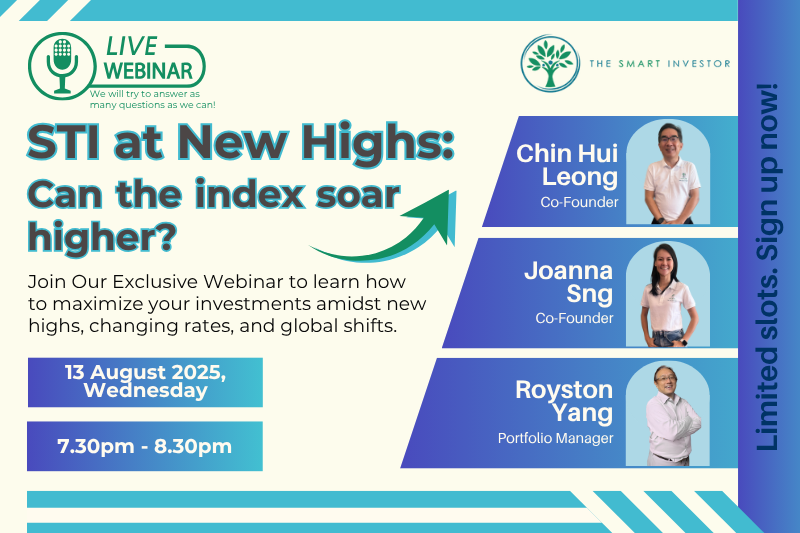Winds of change are coming to the Singapore bourse, which is good news for investors.
Singapore Exchange Limited (SGX: S68), or SGX, has seen a flurry of delistings in recent months while the initial public offer (IPO) pipeline remains dry.
In the first five months of this year, there was only one IPO – that of Vin’s Holdings (SGX: VIN) on Catalist.
At least 16 companies are on the delisting timetable as of the first week of May, with these 16 having been either delisted, confirmed their delisting dates, or announced plans to exit the stock market.
Investors should note that the Monetary Authority of Singapore formed an equity markets review group last August to recommend measures to stimulate and revitalise the equity market here.
In the same vein, SGX has proposed regulatory changes to shift towards a more disclosure-based regime and also to ease the requirements for companies to list their shares here.
We go through five of these potential changes.
1. Less prescriptive disclosures
SGX’s regulatory arm (SGX RegCo) is proposing to move away from prescribing what companies should do.
Instead, RegCo will emphasise sufficient disclosures to ensure investors obtain enough information for their investment decision-making.
SGX will also ensure that more material information is disclosed in a timely and accurate manner.
This is to allow investors to differentiate between companies with strong versus weak corporate governance.
The aim is for RegCo to achieve a balance between appropriate disclosures, which will protect investors, and being overly prescriptive by asking companies to disclose even minute details.
SGX hopes to alleviate the burden on disclosures by proposing this and allowing companies the discretion to decide on what’s material and whether it should be disclosed.
2. Streamlining mainboard IPO qualitative requirements
SGX RegCo is looking to streamline the quantitative criteria for mainboard listings as the current process is viewed as being too onerous.
The proposals are aimed at ensuring that the time and costs of preparing and compiling the information required for prospectuses are commensurate with their informational value.
In other words, unnecessary information can be left out while making disclosures more succinct and relevant for investors.
An example would be the current need to enlist an outside expert to confirm the company’s profit predictions.
The Monetary Authority of Singapore (MAS) is looking to do away with such a requirement; instead, the issuer’s board of directors should be responsible for ensuring that forecasts are prepared according to accounting policies and are based on reasonable assumptions.
By doing so, the process reduces hassle for the company and cuts down significant time and effort.
3. Streamlining mainboard IPO quantitative requirements
Apart from qualitative criteria, SGX is also looking to recalibrate certain quantitative admission criteria, with a focus on the profit test for mainboard listing aspirants.
RegCo’s CEO Tan Boon Gin says that SGX plans to retain a prescriptive approach when it comes to financial health and the track record of directors, etc.
That said, disclosures still need to be clear and comprehensive enough for investors to make well-informed decisions.
On a related note, the MAS is also looking to align Singapore’s disclosure requirements for secondary listings with international standards.
An amendment would allow listed overseas companies to use their existing prospectuses and make minimal adjustments when dual-listing on SGX, rather than requiring these companies to comply with issuers seeking a primary listing.
4. Removal of SGX Watch-List
SGX RegCo is proposing to scrap the much-talked-about SGX Watch-List as it believes that being on this list will generate negative sentiment towards these businesses and result in difficulties in obtaining financing.
This leads to a vicious cycle where the company is unable to exit the Watch-List if it cannot raise funds or refinance its debt to ensure ongoing business operations.
However, issuers still need to report losses for three consecutive years so that investors are kept in the loop.
Pending the outcome of this consultation, SGX will suspend the half-yearly reviews that place issuers on the Watch-List.
5. Reducing public queries to avoid alarm
Finally, SGX RegCo proposes a more targeted approach to raising queries and will consider the materiality of the issue before doing so.
The complaint is that such moves cause unnecessary alarm to investors and may paint the company in a bad light.
Instead of publicly querying issuers on unusual share price movements, these engagements will now be private between SGX and the issuer.
Public disclosure requirements will still be needed for price-sensitive information.
However, the validity period of trade-with-caution alerts shall be just two weeks, and SGX RegCo will also refine its approach when it comes to suspending issuers.
Looking to create a lifelong income stream? Check out our report, ‘7 Singapore Blue-Chip Stocks That Can Pay You for Life.’ We uncover a powerful lineup of dividend-paying stocks with the reliability and growth potential you need in today’s market. Don’t miss out on these dependable picks. Download your copy now and start building a secure financial future!
Follow us on Facebook and Telegram for the latest investing news and analyses!
Disclosure: Royston Yang owns shares of Singapore Exchange Limited.





